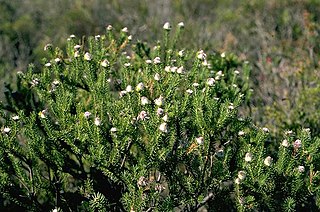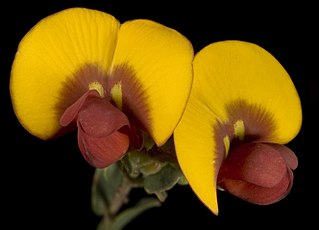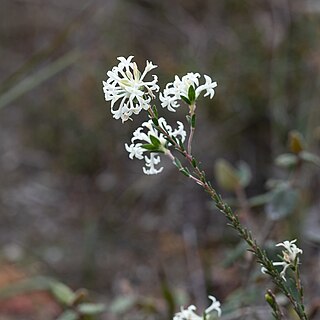
Grevillea preissii is a species of flowering plant in the family Proteaceae and is endemic to the southwest of Western Australia. It is a mounded to spreading or dense, erect shrub, the leaves divided with 5 to 7 linear to more or less cylindrical lobes, and groups of reddish flowers arranged along one side of the flowering rachis.

Grevillea huegelii, commonly known as comb spider-flower or comb grevillea, is a species of flowering plant in the family Proteaceae and is endemic to southern continental Australia. It is an erect to low-lying shrub with divided leaves with mostly three to eleven sharply-pointed linear lobes, and clusters of red to pink flowers that are silky-hairy on the outside.

Grevillea candolleana, commonly known as the Toodyay grevillea, is a species of flowering plant in the family Proteaceae and is endemic to a restricted part of the south-west of Western Australia. It is a shrub with narrow egg-shaped to linear leaves and white to cream-coloured flowers.

Grevillea cirsiifolia, commonly known as varied-leaf grevillea, is a species of flowering plant in the family Proteaceae and is endemic to the south-west of Western Australia. It is a prostrate shrub, usually with divided leaves with eight to thirty lobes, and creamy white and bright yellow flowers with a white to pale yellow style.
Grevillea pinifolia, commonly known as the pine-leaved grevillea, is a species of flowering plant in the family Proteaceae and is endemic to a restricted area in the south-west of Western Australia. It is a low, mounded shrub with linear, more or less cylindrical leaves and red to orange-red flowers.

Grevillea shuttleworthiana is a species of flowering plant in the family Proteaceae and is endemic to the south-west of Western Australia. It is a more or less erect shrub with variably-shaped leaves, the shape depending on subspecies, and cylindrical clusters of cream-coloured to yellow or greenish flowers, often held above the foliage.

Petrophile drummondii is a species of flowering plant in the family Proteaceae and is endemic to southwestern Western Australia. It is a shrub with rigid, pinnate leaves with needle-shaped, sharply-pointed pinnae, and spherical heads of hairy, fragrant, yellow flowers.

Petrophile scabriuscula is a species of flowering plant in the family Proteaceae and is endemic to southwestern Western Australia. It is a dense, prickly shrub with sharply-pointed, needle-shaped leaves more or less pressed against the branchlets, and oval heads of hairy, yellow to creamy-yellow flowers.
Dillwynia dillwynioides is a species of flowering plant in the family Fabaceae and is endemic to the south-west of Western Australia. It is a low-lying or erect, spindly shrub with cylindrical, grooved leaves and yellow, red or orange flowers with yellow, red or orange markings.
Pultenaea aspalathoides is a species of flowering plant in the family Fabaceae and is endemic to the south of Western Australia. It is an erect, spindly shrub with hairy, needle-shaped leaves and yellow flowers.

Pultenaea empetrifolia is a species of flowering plant in the family Fabaceae and is endemic to the south-west of Western Australia. It is a spindly, prostrate or spreading shrub with down-curved, cylindrical, grooved leaves and yellow to orange and red flowers.

Pultenaea ochreata is a species of flowering plant in the family Fabaceae and is endemic to the south-west of Western Australia. It is an erect shrub with egg-shaped leaves with the narrower end towards the base and yellow-orange flowers with red or brown marks.

Gompholobium ovatum is a species of flowering plant in the family Fabaceae and is endemic to the south-west of Western Australia. It is an erect or prostrate shrub with egg-shaped leaves and yellow and red to purple, pea-like flowers.

Bossiaea pulchella is a species of flowering plant in the family Fabaceae and is endemic to the south-west of Western Australia. It is a slender, erect shrub with egg-shaped leaves, and orange-yellow, purplish brown and dark red flowers.

Gompholobium preissii is a species of flowering plant in the family Fabaceae and is endemic to the south-west of Western Australia. It is an erect shrub with pinnate leaves with five to fifteen leaflets, and yellow, red and orange, pea-like flowers.

Gompholobium shuttleworthii is a species of flowering plant in the pea family Fabaceae and is endemic to the south-west of Western Australia. It is an erect shrub with pinnate leaves with five to nine leaflets, and pink or purple flowers with some darker markings.

Gompholobium villosum is a species of flowering plant in the pea family Fabaceae and is endemic to the south-west of Western Australia. It is a slender, erect shrub with simple, needle-shaped leaves with one or two grooves on the lower surface, and violet, pink or purple flowers.
Pultenaea strobilifera is a species of flowering plant in the family Fabaceae and is endemic to the south-west of Western Australia. It is an open to dense, domed or spindly, erect shrub with simple leaves and yellow-orange and salmon pink to bright pink flowers.

Sphaerolobium macranthum is a species of flowering plant in the family Fabaceae and is endemic to the south-west of Western Australia. It is an erect shrub with only a few scale-like leaves, and yellow or orange and red flowers.

Pimelea phylicoides, commonly known as heath rice-flower, is a species of flowering plant in the family Thymelaeaceae and is endemic to southern continental Australia. It is an erect shrub with densely hairy young stems, narrowly egg-shaped to elliptic leaves, and heads of white flowers surrounded by 3 to 6 involucral bracts.
















